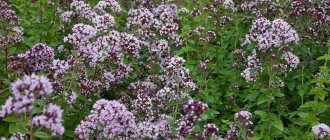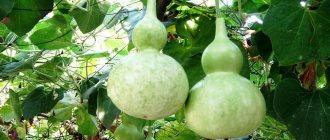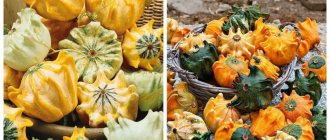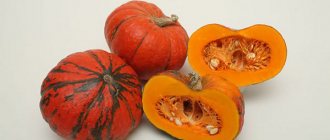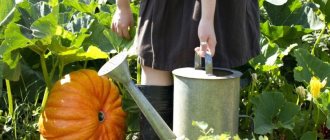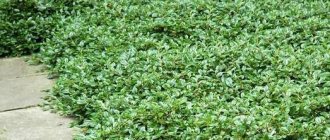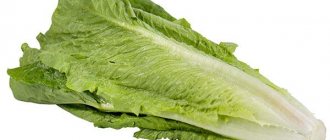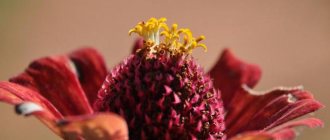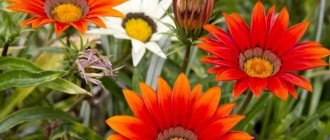Wax pumpkin is a special type of pumpkin that not everyone is familiar with yet. In our area, this pumpkin is rarely grown due to the fact that its growth requires special conditions. Benincasa wax pumpkin - this is the name this pumpkin bears; it is somewhat different in appearance from the bright orange fruit we are used to. Wax gourd juice is another advantage of the fruit. Wax pumpkin, the recipes for which are very diverse, is tasty and healthy. Today we will talk about what a wax pumpkin is and what are the features of this product. You will also find out where to buy wax gourd seeds and how much they cost. Read the following article on the pages of the magazine.
Description
The main characteristics are:
- Stems. Thin, reaching a length of 4 m. Covered with medium-sized leaves.
- Flower. It blooms very beautifully - several large orange flowers with a rich aroma appear at the same time.
- Fetus. If good conditions are created, vegetables weighing up to 10 kg can be grown. They have an oblong shape and a greenish tint. The top is covered with a waxy coating and small villi that perform a protective function.
- Pulp. Pale white color. Juicy, has a sweetish taste with a slight sourness.
Main characteristics of Benincasa pumpkin:
| Growing season, days | Fruit weight, kg | Time of planting seedlings, month | Time to transplant into soil, month | Time for sowing seeds in the ground, month | Productivity, fruits per bush |
| 80 | 4-5 | 4-5 | 5-6 | 5-6 | 12 |
You can learn more about the features and properties of the Benincasa wax pumpkin while watching the presented video:
Description of culture
The plant belongs to the group of liana crops. The faceted stems reach 4 m. The wax gourd has much smaller leaves compared to other species. The flowers of the plant have an orange tint; after flowering, fruits appear in their place. Green pumpkins are covered with a slight waxy coating.
The vegetables themselves are light green in color and oblong in shape, growing up to half a meter in length. Their weight reaches 10 kg. Pumpkin ripens at the end of August or the beginning of September. Even with a delicate shell, the vegetable is stored longer than other varieties: pumpkin tends to lie without spoiling for up to 3 years at 25°C. This occurs due to a waxy coating.
The white flesh of winter squash is very juicy and has a homogeneous mass. It tastes sweet and sour. Wax gourd contains B vitamins and minerals such as iron, potassium, phosphorus, sodium and calcium. The vegetable is also useful for normalizing the central nervous system and increasing the performance of the cardiovascular system. In eastern countries, pumpkin is used as a diuretic, analgesic and antipyretic agent.
Healing qualities of the plant
The Benincasa variety is unique in that the fruit contains useful enzymes that are not found in any other variety. That is why Tibetan healers cultivate it in large quantities in order to make potions from the resulting raw materials.
All parts of the plant are used in Eastern medicine in a variety of ways:
- as an aphrodisiac;
- as a laxative;
- for the prevention and removal of parasites from the body;
- to increase appetite and improve gastrointestinal function;
- from nervous system disorders;
- as an antifever agent;
- to remove excess fluid from the body (as a diuretic);
- in the treatment of sexually transmitted infections;
- to increase lactation in nursing mothers.
Wax gourd is also used for weight loss.
Doctors recommend the Benincasa variety for diabetics, hypertensive patients, people with diseases of the urinary organs and myocardial ischemia. The vegetable improves metabolic processes in the body. Doctors advise eating it every day as a diuretic and anti-inflammatory agent.
On a note. Wax gourd copes well with swelling of the hands and feet and normalizes blood pressure.
Residents of China use flower buds and young pumpkin leaves for food. Tendrils and shoots are used as spices (instead of herbs). From the seeds of the vegetable, a fat-rich oil is obtained, suitable for medicinal use and food consumption.
There is an opinion that Benincase acts as a normalizing gastric microflora and a thirst quencher. In addition, wax gourd rids the body of excess starch and has antipyretic properties. Since it acts as a diuretic, it is used for chronic nephritis and edema, including in expectant mothers.
The pulp of the fruit acts as an anesthetic when used externally and internally. The juice of the vegetable is used to treat fever and some diseases of the epidermis. The seeds are used as a sedative and tonic.
On a note. The Chinese believe that wax gourd seeds prolong a person's life.
In Tibetan medicine, Benincase is used for medicinal purposes. The list of diseases that are treated with this vegetable is quite large:
- arthritis;
- stomach pathologies (for example, peptic ulcer);
- obesity of any degree;
- diseases of the urinary organs;
- gastritis;
- vascular atherosclerosis.
In addition, Benincasa juice frees the body from excess radiation.
Pumpkin has practically no contraindications. The exception is individual intolerance to the product. Its use also does not produce side effects.
Winter pumpkin is valued not only for its medicinal properties: it is widely used in cooking throughout the year. When preserved, the vegetable goes well with cucumbers, peppers and tomatoes. Many delicious dishes are prepared from Benincasa: it can be canned, stewed, made into soups and porridges. The young vegetable is also eaten raw.
Delicious and healthy candies are also made from winter pumpkin. Simply cut the vegetable into small slices and sprinkle with sugar or powdered sugar. For variety, add cinnamon or lemon juice to the powder.
Pumpkin seeds, after roasting, have a high calorie content and excellent taste. They are good to take on a long journey and use as a sedative.
Beneficial features
Benincasa fruits contain many vitamins and nutrients, which is why pumpkin is often used for medicinal purposes. Not only the pulp, but also the peel, seeds, and leaves have medicinal properties.
Consumption of wax gourd is recommended for diabetes, cardiovascular and gastrointestinal diseases.
What is the benefit:
- improves the functioning of the gastrointestinal tract;
- normalizes metabolism, which makes it easier to lose weight;
- has a diuretic effect, which helps in the fight against high blood pressure;
- removes excess cholesterol from the body;
- has an antipyretic effect;
- increases the body's protective functions;
- cleanses the body of toxins, especially in case of alcohol poisoning;
- reduces the load on the cardiovascular system;
- relieves swelling;
- wax is used in cosmetology.
How do you eat Benincasa?
Benincasa fruits are very convenient to use - they fully fit the format of currently fashionable portioned pumpkins. Benincasa fruit halves are ideal for stuffing. They can also be boiled, stewed, used to make soups, canned, candied... In general, they are good in any form! Including fresh - the flesh of benincasa is white, sweet, aromatic, very tasty! By the way, the fruits can be used not only fully ripe, but also unripe.
In addition, benincasa's young leaves and buds are edible and are added to fresh salads.
Pumpkin pulp has diuretic and antipyretic properties. The pulp around the seeds is eaten as a pain reliever. Raw seeds can be chewed - they tone and guarantee longevity. This is exactly what they think in the East. Well, fried seeds are a wonderful delicacy!
How to grow?
There are several features of growing wax gourd.
Through seedlings
In the North and central regions, the vegetable is grown in seedlings.
Time and method of sowing
Seeds for seedlings are planted 25-30 days before transplanting to a permanent place.
What should be done:
- prepare a container for planting, preferably peat pots;
- fill them with soil for seedlings;
- make a hole in the soil, 1-2 cm deep;
- Place 2 seeds in each hole;
- sprinkle with earth;
- pour water at room temperature;
- move the pots to a south-facing windowsill.
After germination, the weaker sprout is carefully cut off with scissors.
Conditions for growth
For seedlings to grow well it is necessary:
- Temperature. Maintain within 25 degrees. Provide additional insulation until sprouts appear. To do this, cover the pots with transparent film.
- Watering. Do this with a spray bottle. Spray the plants regularly from the moment of planting as the soil dries out.
- Hardening. 1 week before planting in the ground, plants should be taken outside and left for 3-4 hours to allow them to adapt to climate conditions.
Transplantation into the ground
Plants should be planted in the ground closer to the beginning of June, when the weather outside is consistently warm. You can also transplant it into a greenhouse, where the temperature is constantly maintained at 25-30 degrees. This method is suitable for cold climate regions where growing heat-loving vegetables is only possible in a greenhouse.
How to do it:
- pour boiling water over the garden bed;
- dig holes at a distance of 70-100 cm from each other;
- carefully replant the seedlings, along with the peat pot;
- mulch the bed with leaves and humus.
Preparing the bed
You should remember these rules when choosing a place to plant a pumpkin:
- Plot. Good lighting will be required.
- The soil. Planted in fertile soil with low acidity.
- Predecessor cultures. It is better to plant Benincasa in soil in which beans, peas, potatoes, and cabbage previously grew.
Do not use soil in which pumpkins were previously grown.
- Preparation. In the fall, the area needs to be dug up and then manure applied. In spring, add mineral fertilizers.
- Disinfection. To prevent many diseases, additional soil treatment with a solution of ash mixed with water in a ratio of 1 to 10 will help. The liquid is infused for 3 days. It is applied by spraying.
Sowing seeds in open ground
The soil temperature when planting seeds should be at least 10 degrees. Typically this method is used in areas with hot climates.
Boarding order:
- divide the area into rows;
- in each row, dig holes 4 cm deep (follow the pattern as when planting seedlings);
- take 2 seeds;
- put them in each hole;
- sprinkle with a thin layer (about 2 cm) of soil or peat;
- water;
- After germination, pinch out the weaker sprout.
Prevention of diseases and pests
The most common pumpkin diseases are powdery mildew, mosaic and fruit rot. Most often they appear due to increased dampness, which creates favorable microflora for the development of fungi and bacteria. Pests include melon aphids and spider mites.
Prevention measures:
- When the first symptoms of powdery mildew are detected on pumpkin leaves, spray with a fungicide solution. To do this you will need 2 g of copper sulfate or 3 g of potassium permanganate. The substance is dissolved in a bucket of water.
- 1% Bordeaux mixture is treated during the formation of ovaries and leaves. For prevention, water regularly, observe crop rotation and remove the remains of affected plants.
The first signs of mosaic are noticeable even on young shoots. It is manifested by wrinkled, mosaic and chlorotic leaves. Later, the leaf blade of the affected seedlings bends inward, and over time, the growth of the entire plant slows down. Pumpkin mosaic is a dangerous viral disease; affected plants are removed and burned away from the garden.
To destroy a mosaic at the initial stage:
- remove affected areas in a timely manner;
- destroy weeds;
- disinfect garden equipment.
If the plant becomes infected during the growing season, the seedlings are treated with a Farmayod solution.
Important! To prevent pumpkin infection with mosaic, the seeds are treated with a weak solution of potassium permanganate before sowing.
Rotten areas of the fruit are carefully removed with a knife. The resulting wound is wiped with aloe juice. The rubbed area dries out, but the fruit continues to develop.
To protect against aphids, weeds are first removed, then the plant is sprayed with a soap solution (100 g of ground soap per 5 liters of water) or 10% karbofos (30 g per 5 liters of liquid).
To combat spider mites, onion infusion (100 g of onion peel per 5 liters of water) or a 20% chloroethanol solution (10 g per 5 liters of liquid) will help.
One of the advantages of Benincasa is that, unlike other varieties of pumpkin, it is practically not affected by diseases and is more resistant to pests.
Care
We should not forget about the rules of agricultural technology.
Watering
The recommendations are as follows:
- Frequency. Immediately after the prank, it is necessary to water the plants daily. After 1 week, you can reduce the frequency to 2 times in 7 days.
- Temperature. Water for irrigation should be warm, about 20 degrees. Cold water can destroy the vegetable.
- Time. It is better to add water in the evening, when the heat subsides. If you do this during the day, a crust will form on the ground, and if water gets on the leaves, they may dry out.
- Quantity. 1 plant requires about 5 liters of water.
- Way. Pour water under the roots, avoiding exposing them.
Feeding
What are the rules:
- Compound. You can prepare a mixture of ammonium nitrate, ammophos and potassium sulfate in a ratio of 2 to 4 to 2. The finished mixture should be added to 10 liters of water. 1 plant accounts for 4 liters.
- Frequency. During growth, it is necessary to make at least 2 feedings - after the appearance of the 4th leaf and the formation of lashes.
Bush formation
Some tips to help you grow pumpkins include:
- formation will be more convenient if you put a trellis on the site;
- you need to direct the growth forces to 1 stem; for this, all side shoots are removed;
- The central stem is pinched after 3-4 ovaries appear.
Pollination
Usually carried out by bees. But if for some reason they rarely fly to the site or the pumpkin grows in a greenhouse, you can do it manually.
Actions:
- choose a warm sunny day;
- carry out the procedure in the morning;
- take a soft brush and use it to collect pollen from the “male” flower;
- bring it to the “female” flower and carry out pollination.
Pest and disease control
Parasites dangerous to Benincasa are:
- Melon aphid. Causes damage to ovaries and leaves, causing them to curl and rot.
It starts due to the abundance of weeds on the site, so you need to pay attention to weeding. You can also spray the pumpkin with a low concentration soap solution. - Spider mite. It sucks the juices out of pumpkin leaves and then covers them with a layer of cobwebs, which leads to death.
Onion and garlic infusions help against ticks.
Possible diseases include:
- Root rot. A fungal disease that attacks the plant starting from the root.
The result is complete death. Controlling the quantity and quality of watering and the frequency of fertilizing will help to avoid the development of the disease. - Powdery mildew. The first signs of the disease are light spots on the surface of the plant, which gradually merge into 1. The result of development is the death of the plant.
Fungal spores may be present in the soil, so you need to: - carefully dig up the bed;
- observe crop rotation;
- Spraying hay with tincture also helps.
reduce the amount of applied nitrogen fertilizers (organics) and increase phosphorus-potassium ones;
The disease is transmitted by insects, so you need to protect the plant from them in advance by treating it with insecticides, for example, Fitoverm. For those who do not want to use chemicals, we can recommend spraying with an infusion of onion peels. Prepared at the rate of 200 g of raw materials per 1 bucket of water.
Benincasa care
Supports are placed above the beds, as for cucumbers. As they grow, the shoots are wrapped around ropes or rods. All side shoots are removed to a height of 1 m. And above, the side vines are pinched, leaving 1 fruit on each. It is better to leave no more than 4 pumpkins on one plant, otherwise they may not ripen completely. As soon as they begin to fill, they must be tied and tied to a horizontal bar, otherwise they may come off under the weight of their own weight.
Well, if you are too lazy to bother and the area of the plot allows, you can grow benincasa in a spread. In this case, the distance between plants should be 2 m.
Harvest and storage
What you need to know about it:
- Time. It is better to harvest before the onset of frost.
- Method of collection. The fruits must be carefully cut using scissors or a knife, while taking care to preserve the stalk.
- Sorting. Immediately after harvesting, vegetables need to be sorted. Only fully ripened pumpkins that are free of any damage are suitable for long-term storage. All the rest are best consumed soon or cut into pieces and frozen.
- Caution. The waxy layer on the surface of the fruit should never be washed off or washed off, because it is thanks to it that pumpkins can be stored for a long time.
- Conditions. Does not require special storage conditions. It is enough to place it in a cool and dark place.
Benincasa pumpkin can be stored at home, in a room, as long as it is not exposed to direct sunlight.
Harm of wax gourd and contraindications for use
With normal consumption of the product there is no harm to the body. Wax gourd is contraindicated only for those who experience allergic reactions when consuming it or applying it externally. There have been cases where winter squash leaves have caused itching and redness when applied externally.
When taking wax gourd fruits, allergies or intolerances are extremely rare. Pumpkin can be consumed by pregnant women, people with diabetes and obese people.
Advantages and disadvantages
The main advantages of culture are:
- Storage. Can be stored for up to 2 years.
- Transportability. The fruits can withstand transportation without loss of commercial quality.
- Agrotechnical measures. They are no different from caring for other pumpkin crops.
- Taste qualities. Benincasa can be consumed raw or cooked. It is canned, prepared into soups, porridges, and purees. The fruits make very healthy candies.
- Decorative properties. Can be grown as a garden decoration.
The only negative is the lack of opportunity to grow vegetables in the open ground of the Northern regions. They do not tolerate cold well and can die at temperatures below -4.
Description of Benincase
Wax pumpkin is a liana-shaped annual with a well-developed root system. Its stems are faceted and can reach 4 m in length, with an average thickness comparable to a pencil. The leaves are smaller than those of other pumpkins, long-petioled, lobed.
The male and female flowers of this pumpkin are very attractive: orange-yellow, large - their diameter is about 15 cm, they have 5 orange petals, very decorative and fragrant.
Benincasa fruits come in round and oblong shapes. Their weight can reach 10 kg, but in the Russian climate, even with proper agricultural technology, fruits rarely grow above 5 kg.
Unripe fruits have a sticky waxy coating and hard bristles (very nice to look at), ripened fruits are smooth, with a thick layer of waxy substance and a white coating, which allow the pumpkin to be stored for a long time without losing its beneficial properties.
Wax gourd stem with inflorescence and ovary. © Zhangzhugang
Reviews
Reviews of people who have already grown this type of crop will help you learn more about wax pumpkin:
★★★★★
Elena, 56 years old. I have been planting Benincasa for the 2nd year now.
Last year's harvest lay in the cellar almost until spring and did not lose any of its external or taste qualities. In our region it is hot in the summer, so we manage to get a good harvest. The main thing is to water and fertilize on time. ★★★★★
Ivan, 61 years old. My wife started growing Benincaza after reading that the fruits help strengthen the cardiovascular system.
Now we plant every year. I can’t say anything about the medicinal properties, but I really like the taste, I can even eat it raw. And my wife says that the fruits improve well-being in case of hypertension. ★★★★★
Maria, 48 years old. I learned about the Benincasa pumpkin from my neighbor.
I really liked the beautiful flowers that appeared on her site. Now I grow these vegetables myself for decorative purposes. As a bonus, I get large fruits that can be added to soups and preserved for the winter. Hide
Add your review
A video review of the Benincasa pumpkin variety can be seen in the following video:
Before growing wax gourd, you need to create suitable conditions for the culture. Take care of the air temperature and lighting, prepare the soil and take measures to prevent pests. This is the only way to grow large and tasty fruits.
0
0
Copy link
Wax pumpkin recipes
The fruits of the wax gourd are eaten both in ripened and unripe forms. Its pulp is juicy with a faint sweetish taste. In Chinese cuisine, pumpkin is fried with meat (pork or beef) and used as a soup base. The soup itself is often served in a cup carved out of a pumpkin. Various candied sweets are also made from pumpkin.
Wax gourd is also called kandol, condol or gondol in the Philippines. There they make candied sweets from it and use it as a filling in national buns. They are also components in some national soups and fried dishes.
In North India and Pakistan, Benincasa pumpkin is used to make Petha sweets. In South Indian cuisine it is used in curries. Also in India there is a dish made from wax gourd and cottage cheese or kefir. The fruit is sometimes made into distinctive-tasting drinks, sweetened with caramel sugar to enhance the flavor.
Wax gourd and shrimp soup
In Southeast Asia, you can find iced tea made from wax melon in stores.
Soup with wax gourd and shrimp recipe
Peel the pumpkin and remove the seeds. Cut the pumpkin into slices 5 cm wide and 5 mm thick. Boil water and add a bouillon cube to it. Then put in the pumpkin. Cook for 20 minutes until the pumpkin is done. Add shrimp, onion, vegetable oil to the broth and cook for another 2 minutes. Remove from heat and serve hot.
Ingredients for cooking: wax gourd – 250 grams, broth – 250 grams, shrimp – 25 grams, leeks, cut into rings, vegetable oil – 10 grams.
Crystal wax gourd recipe
Remove the seeds from the pumpkin and cut it into rings about 5 cm high. To make the rings more beautiful, like in the photo, you can use special molds. Finely chop the chicken breast, ham, shrimp, mushrooms, carrots.
Place the chopped products in a deep frying pan or kettle with heated cooking oil and fry, remembering to stir, for 3-5 minutes. Add salt, water, wine vinegar and pepper. Stir half the cornstarch in cold water and add to the pan to thicken.
Place the pumpkin rings in a steamer bowl and fill them with the pan-fried mixture. Place the rings in the steamer for 8 minutes. Now remove the pumpkin rings from the steamer and place them on a separate plate.
Pumpkin juice with orange for the winter from wax melon
Place everything inside the rings into a saucepan and let it simmer further, adding the remaining cornstarch dissolved in water. Remove the thickened mixture from the heat and fill the pumpkin rings with it again.
For cooking you will need: wax gourd – 500 grams, chicken breast – 20 grams, ham – 20 grams, shrimp – 10 grams, mushrooms – 10 grams, carrots – 10 grams, wine vinegar – 10 grams, cooking fat – 50 grams, corn starch – 50 grams.
Useful qualities
Benincanza has a huge number of beneficial properties. To begin with, they note the high content of pectin, which is very beneficial for the human body. With the help of this substance, toxins, heavy metals and decomposition products are removed from the body. Also, pumpkin pulp has been used at all times as an anti-inflammatory agent.
Benincase is used in diet preparation as one of the main products. This is primarily due to the very low calorie content. In addition, using pumpkin in your diet prevents the accumulation of fatty deposits and a significant decrease in appetite. Pumpkin also quenches thirst very well, so it is important to use in the summer.
It’s not just the pulp that has beneficial qualities. The oil obtained from the seeds of the fruit is very actively used. It is used when performing massage procedures and as a cosmetic product. A distinctive characteristic of the oil is its ability to reduce pain during attacks of cramps or rheumatism. Oil-based creams are used to eliminate dryness and flaking of the skin.
Benincasa pumpkin - waxy, varieties, planting and care
If they now ask me why grow benincasa - wax pumpkin
, when we have so many wonderful varieties of ordinary pumpkin, I will not argue, I would rather agree. Still, this is not our, not Russian history. Although a couple of years ago I had a different opinion.
I read about a miracle pumpkin in a wax coat that can lie in an apartment for a whole year without spoiling.
Its skin is covered with a waxy coating, which saves the vegetable from drying out. If only all cucumbers and tomatoes did the same!
I wanted to grow Benincasa at any cost.
EVERYTHING YOU NEED FOR THIS ARTICLE IS HERE >>>
You won't find such seeds in a small town.
This is understandable; people need to plant potatoes, and not indulge in exotic things. I ordered the seeds through friends who live in the city. They found and sent me only one variety - Akulina
, although I read that in the Moscow region they also grow
the Spanish-73, Goliath, Titan, and Stogruntovaya
.
Benincasa - wax or winter pumpkin
In our country, three types of pumpkin are grown: large-fruited, hard-bark and nutmeg, but little is known in Russia yet about such a species as wax pumpkin, or winter pumpkin, also known as benincasa.
This crop from the pumpkin family is native to the countries of Southeast Asia. Currently, it is widespread in China, Indonesia, India, and also in Latin America. Wax gourd, or winter squash, or winter melon, or Benincasa (Benincasa hispida) is a species of plant of the genus Benincasa of the Cucurbitaceae family.
Wax gourd or Benincasa
Content:
Reviews from gardeners
Opinions about winter squash vary: some are completely delighted with the variety, others are dissatisfied with something, and still others do not want to grow it at all.
Yuri, Orel: “I became acquainted with the Benincasa variety by chance, having tasted a pumpkin pie at my mother-in-law’s. My wife became interested in the product and took several seeds to try. My land is good, clean black soil. Last year I planted pumpkin in seedlings for the first time, but neither the germination nor the further development of the crop met my expectations. There was a minimum of fruit on the frail stems, which by the time of harvest were half as large as promised. When planting and growing, I followed all the instructions, I can’t understand what went wrong. The vegetable is good and healthy, but apparently my type of soil is not at all suitable for it.”
Yaroslav, Gelendzhik: “Several years ago, a neighbor shared winter pumpkin seeds. Since then I have grown this vegetable crop every year. Pumpkin is very healthy and comes in convenient sizes. One fruit is enough for my large family to eat. I store pumpkin under the sofa - a great space saver! And an even bigger advantage is that it does not cross-pollinate with other types of pumpkin. This is very important for me, since I grow several species at once. I also heard that this crop can be grown even in an apartment: for this you need a large flowerpot with a volume of about 7 liters. This is not much, considering that it puts out beautiful lashes up to 4 m. It’s a kind of decor. I want to try."
Irina, Tver: “I have been growing winter pumpkin Benincasa for five years. I like that wax pumpkin can be easily stored at room temperature for several years, the main thing is not to rub off the protective coating. It tastes like zucchini. Children eat it raw with pleasure. Agricultural technology is practically no different from ordinary and nutmeg pumpkin. My whole family likes the vegetable; I plan to grow pumpkin all the time.”
Description of the plant
Wax pumpkin, or winter pumpkin as it is also called, is a plant of the Cucurbitaceae family. There are many names that can be used for this plant:
- Chinese calabash;
- white Indian pumpkin;
- Benincasa.
The fruits of this plant are characterized by an oval shape. The length does not exceed 60 cm. The average weight of the fetus is within 4 kg. The peel has a pale green color and a fairly high density. A special feature is a waxy coating on the surface of the fruit that is bluish in color. The inside is white. China is rightly called the homeland of the plant.
The undeniable advantages include the fact that the fruits are stored for a very long time. Under suitable conditions, pumpkin can be stored for up to 3 years. At the same time, over time, an increasingly waxy coating forms on it, which is a kind of cocoon that protects from the negative effects of the environment.
Planting seedlings in open ground and caring for them
Plants should be planted on the site in May or the first half of June. Place seedlings at a distance of 0.7 to 1 m from each other.
Before planting the seedlings, water the holes with boiling water.
The first week, water the plants every day. Use water only at room temperature. As soon as the seedlings are well rooted, reduce the watering procedure to twice every 7 days.
Caring for Benincase in open ground:
- Fertilizer. This type of pumpkin is quite sensitive to fertilizing. In order for the plant to develop well, you need to use a composition of potassium sulfate, saltpeter, ammophos and 10 liters of water. All components must be taken in equal proportions (20 g). At least 4 liters of liquid should be poured under each plant. It is recommended to use this fertilizer 2-3 times a season.
- Topping. In order for the pumpkin to produce a bountiful harvest, it is necessary to carry out artificial pollination. To do this, using a soft brush, you should carefully transfer the pollen from male to female flowers. As for pinching, the procedure should be carried out at the end of August. Some gardeners recommend doing this immediately after the first ovary appears.
- Pests. As for diseases, wax gourd can only be affected by aphids. If insects appear, the plant must be treated with a special product. You can buy it at any specialized store.
Harvesting must be done before the first frost. The fruit must be removed with the stalk.
When harvesting, remember that unripe pumpkin will not be stored for long. Therefore, it must either be frozen in the freezer or eaten as quickly as possible.
Wax gourd is a real storehouse of vitamins. As you can see from the article, growing it is quite simple, the main thing is to follow the recommendations and simple rules.
